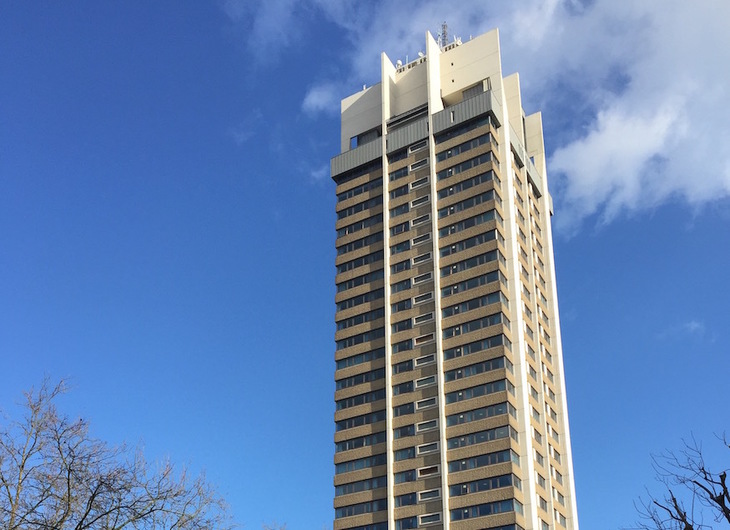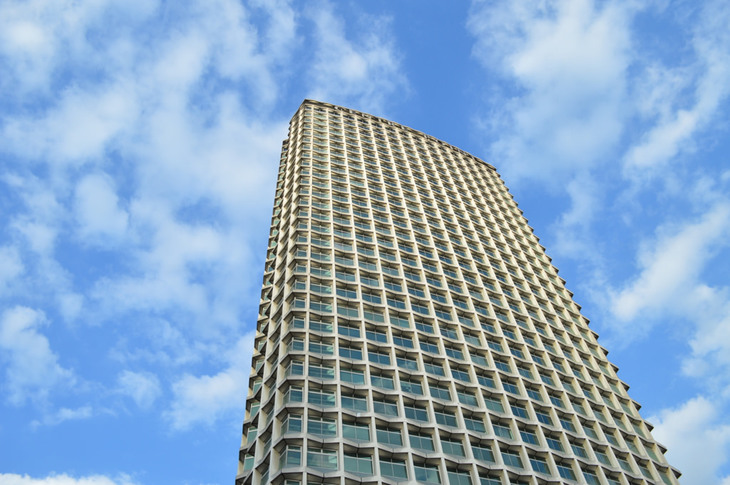
Concrete-heavy brutalist architecture divides people. Some love it, some hate it. Martin Latham falls into the latter camp. In this highly opinionated extract from Londonopolis — his superb book about the capital — Latham describes the misery and megalomania behind London's brutalist buildings.
Seven obscure men in suits did more damage to London than the Luftwaffe. These were the leading British brutalist architects, who dotted London with cement monoliths. They were all inspired by one great notion, the radical German Bauhaus movement.
The Bauhaus
The leading light at the Bauhaus art school in 1920s Germany was an architect called Walter Gropius, a Berlin genius who married [composer Gustav] Mahler’s widow. His one London house, in Chelsea Old Church Street, is a modern masterpiece which, unlike later brutalist homes, actually works for humans. It is like a long, low garden room and complements the old houses around it. But Gropius’s eloquence, his talk of ending ‘salon art’ and of a ‘machine economy’ went to the heads of his followers. Art historian Ben Davis tracked down a surviving Bauhaus member, a German who called himself Tut. Tut recalled the Bauhaus as a ‘dippy aesthetic commune’ full of short-skirted girls and shaggy-haired theorists. Hitler was unsurprisingly unimpressed. He closed the Bauhaus school down in 1933.

Little did the Führer know that those 100 or so Bauhaus members would achieve, by inspiration, what the full might of his air force failed to do: the disruption of London’s traditional skyline. The Bauhaus inspired the idea of concrete mass housing for the ‘proletariat’. Old notions of beauty were sacrificed to the idea of a house as ‘a machine for living in’. The most important practitioner of Bauhaus architecture was Henri Le Corbusier, whose dreadful grid-plan city in India I have stayed in.
Brutalism
The Bauhaus was revered for decades by the English chattering classes. Bauhaus was radical, it was obscure, and it lent god-like status to architects. In the 1950s and 1960s, it was the inspiration for a new architectural movement, brutalism. This produced some fine, well-functioning London buildings, but, in hundreds of cases, it caused the sort of fundamental misery depicted in JG Ballard’s 1975 novel High Rise. In the novel, Ballard’s arrogant architect ends up setting dogs on to the disgruntled residents of his London tower block.
Ballard’s backlash against the high-rise was reinforced by Tom Wolfe’s 1981 book From Bauhaus to Our House, which first revealed the baleful legacy of this brutal building style in cities. In the same vein, in 2009 Hal Foster, curator of the Museum of Modern Art’s Bauhaus exhibition in New York, could write in his exhibition catalogue: ‘Bauhaus committed the original sin of modernism, its naïve hunger for universals.’
The following seven ‘unmagnificent men’ were major brutalist architects.
Sir Basil Spence

Sir Basil Spence (1907–76) lived in a Tudor cottage in Yaxley, Suffolk. Spence, a remorseless self-publicist with a Terry-Thomas moustache, was a bounder. His disregard for context — and for peasants — is shown in the lavish interiors and furniture he designed for the viceroy’s palace in New Delhi. After this, Spence designed tower blocks for Glaswegians, which caused such misery that they have been demolished.
It seems incredible that permission was granted for his brutal, Orwellian Ministry of Justice (ex-Home Office) near St James’s Park. He insisted on ‘geometric monumentality for London’. His most notorious building is the high-rise tower block of the cavalry barracks in Knightsbridge, which he justified in feverish language: ‘It is a muscular tower, not mimsy-pimsy. It’s for soldiers. On horses. In armour.’ Sydenham council is battling to demolish his Sydenham School and residents of his blocks of flats in Feltham and Shepperton certainly have reason to regret Basil’s career choice.
John Bancroft

John Bancroft (1928–2011) lived in an old country cottage. A London County Council architect, his low point was his Pimlico Comprehensive School of 1964, a concrete block sunk in a concrete rectangle, ‘like a battleship’. Like much brutalist architecture in London, it was technically incompetent. Clashing with its surroundings, the rain-streaked cement cracked and spalled. Pupils baked in summer but shivered in winter. There is a 2009 online interview of him at home, surrounded by antiques, saying how wonderfully the building works. The education authority Ofsted put the school on ‘special measures’ and Westminster Council, wisely identifying brutalism as the problem, demolished it in 2010, in the teeth of a campaign by academics to preserve it.
Richard Seifert

Richard Seifert (1910–2001) lived in a walnut-panelled north London house with a 1.2-hectare (3-acre) garden. Seifert was a wheeler-dealer who dropped his Jewish first name, Rubin, and mysteriously styled himself Colonel Seifert. Driven everywhere in a Rolls, he was the first architect millionaire. Even a friendly obituary referred to his ‘buccaneering activities’ and ‘impregnable self-righteousness’. He is the biggest offender of the seven, having cynically littered London with over 600 low-spec variations on a shoebox. His modus operandi was bending planning rules. His triumph was Centre Point (117m/385ft) high. Here he used legal loopholes to break planning guidelines restricting height, and bribed the car-worshipping planners with a new roundabout. Centre Point, at the bottom of Tottenham Court Road, is both ugly and a white elephant, having no pavements. With its much-derided cost-cutting low ceilings, it has lain empty for much of its life.
Among his achievements, the Tolworth Tower has kept Tolworth a dangerous and deprived area, the Royal Garden Hotel looms over Kensington Palace (it made Princess Margaret cry), the King’s Mall shopping centre turned Hammersmith into, well, anywhere, and the Hilton Hotel in Edgware Road and the Holborn Centre are soulless tracts in the centre of London. His NatWest Tower is the only building which Londoners might have thanked the IRA for bombing (fortunately casualty-free). After a long battle, in 2014, Network Rail got permission to demolish Seifert’s gimcrack Euston Station.
John Poulson

John Poulson (1910–93) lived in various Yorkshire mansions. Poulson was sentenced to seven years in jail for rigging planning decisions and bribing councillors. The judge called him ‘incalculably evil’ and even his defence QC called him ‘self-righteous, and something of a megalomaniac’. His connections with Home Secretary Reggie Maudling led to Maudling’s resignation but his concrete monuments remain: flats, offices and [blocks next to] Cannon Street Station, Waterloo Station and East Croydon Station, all of which have worsened Monday mornings for millions. He was not even a properly trained architect. When his first employer heard that Poulson was setting up a practice he said, ‘Christ, he couldn’t design a brick shithouse.’
Sir Frederick Gibberd

Sir Frederick Gibberd (1908–84) lived in a country house in Essex, which housed his large collection of paintings. Quietly prolific and consistently uninspired, this Coventry tailor’s son wrote books on town design and was proudest of his Harlow New Town in Essex. He did damage in London with Arundel Great Court, a giant concrete block which erased three ancient streets between the Strand and the Thames, including the house where Tsar Peter the Great had lodged. Pevsner lamented its ‘drab efficiency’ (1) but at least this is only used as offices: people actually have to live in Gibberd’s modernist estates in Streatham, Sydenham and Southgate.
Peter Smithson

Peter Smithson (1923–2003) spent many of his years in clean, orderly Bath. I think he was mad — a simplistic word which I do not use lightly. Luckily the BBC made an early documentary about Peter, who usually worked with his wife, fellow northerner Alison. The film was made by working-class Londoner and experimental artist, BS Johnson. Johnson is a cult figure, whose suicide in 1973 adds poignancy to the film. It shows the Smithsons as very creepy, either on drugs or high on their own theory.
Peter, who actually coined the term ‘brutalism’, and called himself Brutus at college, spawned the huge Robin Hood Gardens estate in Poplar, east London. On film, he happily compared the blocks to huge filing cabinets, and obsessed about their cleanliness: ‘no need for grass cutting… easy access from our streets-in-the-sky to mass transit systems’. He insisted that the ‘stress-free’ flats would ‘release them and change them’ (the workers, he meant).
The clue to the Smithsons’ insanity is their clothing in the film. Alison wears a metallic spacesuit top with a pink Lurex tie and Peter is a futuristic spiv. Given a space at the Ideal Home Exhibition, they made a space-age, super-clean habitat, filled with Aryan-style foil-clad inhabitants.
Sadly London’s working class did not fit in with the Smithsons’ ideal. Alison intoned robotically: ‘The week it opened, they would shit in the lifts.’ Asked why by a nervous interviewer, she said ‘It’s social jealousy… London has never faced up to being more than a collection of villages’ – i.e. Londoners should join a Smithson dream of mass living in a concrete utopia. In 2014, after years of crime and misery and despite a campaign by academics to get the Robin Hood flats listed, they were demolished.
If the Smithsons sound like Bond villains, our final brutalist actually was one …
Ernö Goldfinger

Ernö Goldfinger (1902–87) had the decency to live in a modernist house, albeit in privileged Hampstead. Tall, striking Ernö, who grew up in Transylvania, was ‘humourless and tense, explosive and uncompromising’. When he tried to sue Ian Fleming for making him a Bond villain, Fleming asked his publishers if they could put an erratum slip in every copy of Goldfinger to change his name to Goldprick.
Ernö was soaked in Bauhaus thought, having studied with Le Corbusier himself in Paris. Of his three brutalist ‘masterpieces’ in London, Trellick Tower in North Kensington is the most famous. This 30-storey tower of council flats never worked well from the start. I was there: I worked in the small library opposite Trellick Tower in 1974, two years after it was built. I was often terrified, for it was a war zone. People were raped on the often unlit stairwells, which had to be used because the lifts kept breaking down. The library was a refuge for fugitives from gang beatings and muggings. Yes, it was a tough area, but Trellick Tower was the hothouse of brutality. And it did not function as a ‘machine for living in’ either; it was usually either freezing or too hot inside. Trellick Tower now features in pop songs and is a Grade II listed building. The flats, protected by CCTV, guards and intercoms, are now sought-after private residences, but estimates to make Trellick Tower function thermally run into millions of pounds.
Success and failure

Despite the horrors above, the Bauhaus movement did spawn a few of London’s best and most exciting buildings, like the Festival Hall (Leslie Martin), the National Theatre (Denys Lasdun) and the Commonwealth Institute (now the Design Museum, Robert Matthew), and good even came from the ‘unmagnificent’ seven featured above. The fight to save old buildings from their various schemes kick-started today’s building conservation movement.
But brutalism had ‘a flawed recognition of the human element’, a ‘mechanical view of human nature’ (2) and it inflicted miseries which far outweighed its successes. A study of Sunni–Shia relations in Iraq found that the two opposing groups got on best in the old city of Basra because of the intricate medieval street plan, which depended on odd-shaped houses and encouraged continual human interaction. In new Basra and in Baghdad’s brutalist boulevards, Sunni and Shia ghettoes war with each other.
Smithson was wrong. London works best as a series of villages.
Notes
1. Nikolaus Pevsner and Simon Bradley, London, Volume 6, Westminster (Yale University Press, London, 2003), p.370. 2. The words of ex-prison psychiatrist Theodore Dalrymple.
Enjoyed the read? Buy Londonopolis: A Curious History of London in paperback from Batsford for more of Martin Latham's opinionated take on the capital.



